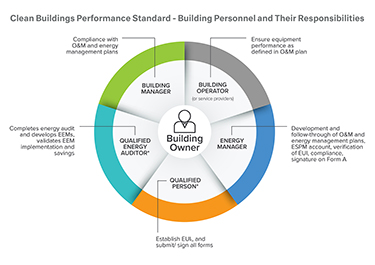|
Subscribe / Renew |
|
|
Contact Us |
|
| ► Subscribe to our Free Weekly Newsletter | |
| home | Welcome, sign in or click here to subscribe. | login |
Construction
| |
 |
April 1, 2022
Don’t ignore new compliance requirements
UMC

Clinton
|
The Washington State Clean Buildings Act passed into law in mid-2019. Enter COVID-19 in March 2020. Health care organizations were hit especially hard with the distractions of the pandemic, making the Washington Clean Buildings Performance Standard as it is now known, and its “years-away” compliance deadlines less pressing a concern than the numerous pandemic-related issues and staff shortages that they have faced on a day-to-day basis. However, the law’s compliance time clock continued to tick away and still does, and the years are not as far away as they may have seemed. With penalties topping out at $5,000 plus $1.50 per square foot every five years, this is not something that health care organizations can afford to ignore or wait until the last minute to address.
Health care organizations, in general, have a more difficult road to travel toward the law’s compliance requirements since most hospitals and other health care occupancies have rarely had formal energy management plans. According to benchmarking data from the city of Seattle’s Office of Sustainability & Environment, 36 out of the 50 medical office buildings are projected to have their energy use measure above their energy use target — a key metric of the new law — with eight buildings projected to be consuming two-fold the energy over the established target. Thirty percent of hospitals are above their energy use target as well.
With Seattle leading Washington state in energy code requirements over the years, it is likely that health care buildings throughout the state clock the same or a worse energy use, indicating an even greater need for energy conservation. In addition, Washington State Hospital Association is very concerned for the Public Health Districts that have buildings over 50,000 square feet, coupled with growing pressure on communities experiencing population shifts as the pandemic has decentralized the workforce.
REQUIREMENTS OF NEW LAW
The Washington Clean Buildings Performance Standard requires that building owners must develop a comprehensive energy management plan, an operations and maintenance plan (commonly called an O&M plan), train their O&M personnel, track and report building energy use, and complete one of the following compliance pathways:
• Meet your Energy Use Index (EUI) target.
• Meet the building investment criteria prior to compliance date.
• Meet target EUI through conditional compliance.
• Meet building investment criteria through conditional compliance.
• In rare cases, compliance through exemption.
STUMBLING BLOCKS
Historically, there have been no requirements for an energy policy to be created and regularly reviewed by top management in health care, but this law changes that. Health care organizations are quite familiar with utility management plans, fire/life safety plans, and safety plans. But with top health care leaders focused on the myriad of other priorities, many health care organizations do not have formal energy management plans that track and report building energy use, have compliant operations and maintenance plans, have consistent and formal training programs to operate the building in an energy efficient manner, or train tenants on how to operate the building. Unfortunately, this results in an environment that is unprepared from an energy management perspective.
Health care facilities are, by nature, too complex to benefit from either a piecemeal approach or the misconception that a new technology, or easy fixes, will solve their energy use challenges.
Health care is a complicated industry with no shortage of issues all grappling for attention, from staffing to patient safety to pandemics to finances, so it is understandable that attention focuses on the organization’s core business — providing critical health care services. Done smartly, energy management shouldn’t come at the expense of world-class health care.
The basic steps to meeting requirements of the Clean Buildings Performance Standard for health care organizations include:
• Benchmark your building to determine your accurate EUI.
• Budget for basic compliance.
• Document your process to lower overall compliance expenses.
• Track for the future of your building.
• Determine if internal or outsourced solutions are appropriate.
OUTSOURCING EXPERTISE
Having an energy manager can help drive the compliance process for health care organizations. There are affordable resources from people who understand and have done this kind of work for years. A qualified energy manager has the technical background and necessary structures in place, has been involved with the Clean Buildings Standards prior to it becoming a law, is in contact with buildings regulators at Washington Department of Commerce, and will show organizations the different paths they could use to comply.
The necessary benchmarking, planning, and reporting is time-consuming, for which many health care organizations are not prepared or well-resourced. An experienced energy manager removes the new law’s compliance burden from the health care organizations’ owners and facilities staff and offers a pathway that can help you begin today and assist you in phasing the costs systematically leading up to compliance. This expertise includes:
• Understanding the 84-page law and associated standards.
• Broad experience with energy management plans.
• Qualified persons and qualified energy auditors on staff.
• Comprehension of the compliance pathways and strategic application for ROI.
• Full-time technical staff prepared to execute and document the correctives.
As energy policies evolve, health care organizations will constantly balance those with mission policies. Utility rate structures are expected to change to include “time of day rates,” which will significantly impact energy costs of 24/7 operations. And electrification efforts throughout the state of Washington will significantly impact hospitals which are very reliant on fossil fuels. These and other mandates will require expertise in energy performance standards and assurance of compliance.
STATE ENERGY POLICY
The state continues to make headlines as further measures emerge to curb buildings’ emissions of climate pollution. The State Building Code Council is strongly weighing stricter decarbonization updates, the city of Seattle is looking to support small commercial buildings living up to the 2019 Clean Buildings Standard, and the state Legislature spent much of the 2022 session considering measures to expand the 2019 law to include buildings down to 20,000 square feet, even multi-residential and commercial spaces. If this language is adopted, the number of Washington’s operating facilities subject to the Clean Buildings Performance Standards with a five-year renewal schedule could more than double.
The trend is clear, and early action can maximize cost-effectiveness: performing the Clean Buildings Performance Standard work now is the first step for health care organizations to being ready for what is to come.
Martin Clinton is building performance services manager at UMC. He has worked extensively with the Northwest Energy Efficiency Council, Washington State University, the Washington Department of Commerce and professional associations to educate on the implications of the Washington Clean Buildings Performance Standard.
Other Stories:
- A boost for health care education at Bates Tech
- Designing a healing river in Sequim
- The lab building of the future is NEXT
- What it takes to build health and science projects
- The challenge of fighting climate change Health
- It’s time to rethink health care design
- A cancer care model with all the right amenities



